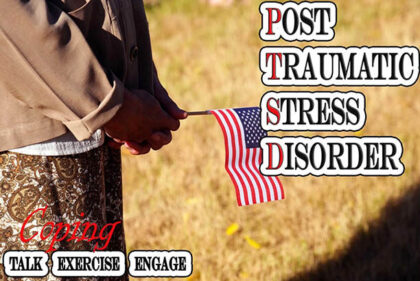
Caring for our beneficiaries with Post Traumatic Stress Disorder remains an important priority for the Defense Health Agency. (Photo: Air Force Airman 1st Class Magen Reeves)
SILVER SPRING, MD — Why do some military servicemembers with traumatic brain injury (TBI) develop posttraumatic stress disorder (PTSD) symptoms, while others do not?
A study in the Journal of Traumatic Stress sought to identify risk factors to help predict what occurs after TBI.
Included in the study were 1,301 U.S. servicemembers and veterans (SMVs) divided into four groups:
- uncomplicated mild TBI (mTBI; n = 543),
- complicated mild, moderate, severe and penetrating TBI (n = 230),
- injured controls (n = 340) and
- noninjured controls (n = 188). 1
The study led by researchers from the Traumatic Brain Injury Center of Excellence examined 25 factors related to demographic, injury-related, military-specific, treatment/health care need and mental health/social support variables. Also participating were military researchers from Walter Reed National Military Medical Center, the National Intrepid Center of Excellence and the Uniformed Services University of the Health Sciences, all in Bethesda, MD; the 33 Area Branch Clinic at Camp Pendleton, CA; the Naval Medical Center in San Diego; and the San Antonio Military Medical Center.
The study found that seven factors were statistically associated with the presence of DSM-IV-TR symptom criteria for PTSD:
- premorbid IQ,
- combat exposure,
- depression,
- social participation,
- history of mTBI,
- need for managing mood and stress, and
- need for improving memory and attention, p <0.001 (51.3% variance).
“When comparing the prevalence of these risk factors in a longitudinal cohort (n = 742) across four PTSD trajectory groups (i.e., asymptomatic, improved, developed, persistent), a higher proportion of participants in the persistent PTSD group reported worse depression, a lack of social participation, and history of mTBI,” the authors noted. “Additionally, a higher proportion of participants in the persistent and developed PTSD groups reported the need for managing mood/stress and improving memory/attention.”
The study pointed out that the presence of ≥1 or ≥2 risk factors was associated with a higher proportion of participants in the developed and persistent PTSD groups, ps <0.001. “These risk factors may be useful in identifying SMVs at risk for the development and/or persistence of PTSD symptoms who may need intervention,” the researchers added.
- Lange RT, French LM, Lippa S, Baschenis SM, et. al. Risk factors for the presence and persistence of posttraumatic stress symptoms following traumatic brain injury in U.S. service members and veterans. J Trauma Stress. 2022 Oct 31. doi: 10.1002/jts.22892. Epub ahead of print. PMID: 36315642.

